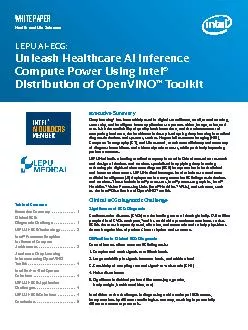/


Deep learning¹ has been widely used in digital surveillance retail manufacturing smart city and intelligent home applications to process video image voice and text With the availability of ID: 838533
Download Pdf The PPT/PDF document "Executive Summary" is the property of its rightful owner. Permission is granted to download and print the materials on this web site for personal, non-commercial use only, and to display it on your personal computer provided you do not modify the materials and that you retain all copyright notices contained in the materials. By downloading content from our website, you accept the terms of this agreement.
1 Executive Summary Deep learning¹ has be
Executive Summary Deep learning¹ has been widely used in digital surveillance, retail, manufacturing, smart city, and intelligent home applications to process video, image, voice, and text. With the availability of quality healthcare data, and the advancement of computing hardware, the healthcare industry is adopting deep learning in medical diagnostic devices and systems, such as Magnetic Resonance Imaging (MRI), of diagnostic work�ows and ultimately reduce costs, while positively impacting patient outcomes. LEPU Medical is a leading medical company located in China focused on research and design of devices and services specialized in applying deep learning technology in digitized electrocardiogram (ECG) interpretation in both clinical and home environments. LEPU Medical leverages Intel so
2 lutions to accelerate and services. The
lutions to accelerate and services. These include Intel® processors, Intel® processor graphics, Intel® Movidius™ Vision Processing Units (Intel® Movidius™ VPUs), and software, such as the Intel® Distribution of OpenVINO™ toolkit. Clinical ECG Diagnostic Challenge Signi�cance of ECG Diagnosis Cardiovascular diseases (CVDs) are the leading cause of death globally. 17.9 million people die of CVDs each year,² and its worldwide prevalence continues to rise. detect irregularities of patients’ heart rhythm and structure. Di�culties in Clinical ECG Diagnosis Several factors a�ect accurate ECG diagnosis: 1. Complex and weak signals at millivolt levels 2. Large variability in signals between leads, and within a lead 3. Sensitivity of sampling rate
3 and signal-to-noise ratio (SNR) 4. Noise
and signal-to-noise ratio (SNR) 4. Noise disturbance 5. body weight, health condition, etc.) In addition to the challenges in diagnosing a wide variety of ECG events, interpretations by di�erent cardiologists can vary, resulting in potentially di�erent treatment protocols. Table of Contents Executive Summary 1 Clinical ECG Diagnostic Challenge 1 2 Intel® Processor Graphics for General Compute Architecture . 3 Accelerate Deep Learning Inference using OpenVINO Toolkit .......................... 4 Intel End-to-End System 4 LEPU AI-ECG Application Challenges 4 LEPU AI-ECG Solutions 4 Conclusion 6 WHITE PAPER LEPU AI-ECG: Unleash Healthcare AI Inference Compute Power Using Intel® Distribution of OpenVINO™ Toolkit Health and Life Sciences L
4 imitation of Existing Diagnostic Softwar
imitation of Existing Diagnostic Software Computer programs for ECG analysis and interpretation were introduced by various companies in the early 1970s and have become an essential tool for physicians over the last 50 years. Traditional diagnostic software is based on signal analysis of the morphology of P, QRS, and T waves. Clinical investigations indicate that the accuracy of these software diagnoses is relatively low. For example: There are substantial rates of misdiagnosis by existing commercial ECG interpretation algorithms.³ Only about 50% of non-sinus rhythms were correctly inferred.⁴ Only one out of seven presentations of second degree AV block were correctly recognized.⁵ These diagnostic errors have limited the adoption of traditional clinical computer-aided ECG interpretation
5 . LEPU AI-ECG Technology The combinatio
. LEPU AI-ECG Technology The combination of the availability of widespread digital ECG data along with rapid advancements in AI computing power and deep learning-based algorithm development o�er an opportunity to rethink the traditional approach to ECG digital signal processing. The availability of these large ECG datasets enables development of accurate deep learning based models to allow e�cient automated ECG interpretation.³ In research settings, convolutional neural networks (CNNs) or deep learning algorithms have been applied to ECG analysis research. But these research e�orts have mostly focused on very limited diagnostic tasks, such as a handful of heartbeat types (e.g., normal, ventricular, or supraventricular ectopic) and rhythm diagnostics (e.g., comm
6 only atrial �brillation or v
only atrial �brillation or ventricular tachycardia). At time of writing, there is no end- to-end solution in the market like LEPU Medical’s Carewell* OmniECG with AI capabilities that can analyze raw ECG data collected from standard 12-lead resting ECG and provide a broad range of clinical interpretations. White Paper | LEPU AI-ECG: Unleash Healthcare AI Inference Compute Power Using Intel® Distribution of OpenVINO™ Toolkit Figure 1 LEPU AI-ECG Multi-lead synchronous analysis. Image Courtesy of LEPU Medical Figure 2 Yellow highlighted area is the Gen9 Processor Graphics die area in Intel® Core i7 6700K for desktop system.⁶ The red dash line enclosed area depicts the SW/HW stack which enables deep learning inference execution and optimization on Intel Processor Graphics.⁷